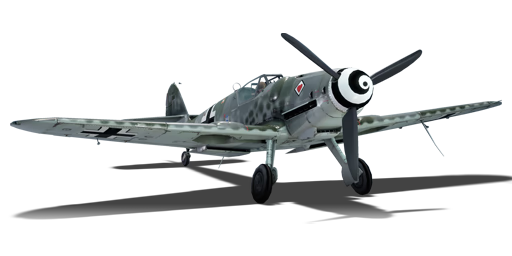



The Bf 109 G-14 was one of the late-war variants of the 109 series. It aimed to standardize all the improvements from the other G models, such as a taller tail, a new engine, and the all-important MW-50 system, which drastically increased power by injecting a methanol-water mix into the engine. This allowed the engine to run at higher boost pressures and significantly increased the top speed compared to the G-6 variant. Although late-war Allied aircraft could outperform the G-14, it was still more than capable with an experienced pilot. Over 5,500 G-14s were built until the end of the war.
Introduced in Update 1.47 "Big Guns", the Bf 109 G-14 is one of the last 109s in the German air tech tree. It features the same 20 mm MG 151 cannon mounted within the propeller hub found in many other 109 variants. However, the twin 7.92 mm machine guns were replaced with 13 mm MG 131 machine guns. Although the new machine guns have a lower ammunition pool compared to the 7.92 mm machine guns, the increase in firepower more than makes up for the difference with the correct ammunition belt. Players can also exchange the 20 mm MG 151 cannon with the 30 mm MK 108 cannon. However, this is not recommended due to the MK 108's extremely poor ballistics, making it only suitable for very close-range engagements. The G-14 also has access to both 2x MK 108 and 2x MG 151 gunpods mounted under the wing. This provides a substantial increase in firepower, but the single propeller-hub MG 151 is more than enough to take down enemy fighters. Unfortunately, the G-14 is severely lacking in ground attack ordnance, with only an incendiary bomb and a 250 kg bomb being available.
flaps
flaps
flaps
brake
| Belt | Belt filling | Armor penetration (mm) at a distance: | |||||
|---|---|---|---|---|---|---|---|
| 10 m | 100 m | 500 m | 1000 m | 1500 m | 2000 m | ||
| IT/IT/APHE/HEI | 21 | 19 | 8 | 3 | 1 | 1 | |
| IT/HEI/HEI/AP-I | 27 | 24 | 14 | 7 | 3 | 2 | |
| AP-I/HEI/HEI/HEI/HEI/IT | 27 | 24 | 14 | 7 | 3 | 2 | |
| APHE/APHE/APHE/IT | 21 | 19 | 8 | 3 | 1 | 1 | |
| FI-T/FI-T/FI-T/IT/IT | 21 | 19 | 8 | 3 | 1 | 1 | |
| HEI/HEI/HEI/APHE/AP-I | 27 | 24 | 14 | 7 | 3 | 2 | |
| Belt | Belt filling | Armor penetration (mm) at a distance: | |||||
|---|---|---|---|---|---|---|---|
| 10 m | 100 m | 500 m | 1000 m | 1500 m | 2000 m | ||
| IT/AP-T/IAI | 19 | 16 | 8 | 4 | 2 | 1 | |
| AP-T/AP-T/IT/IT/IAI | 19 | 16 | 8 | 4 | 2 | 1 | |
| AP-T | 19 | 16 | 8 | 4 | 2 | 1 | |
| IAI | 4 | 4 | 4 | 4 | 0 | 0 | |
| AP-I | 19 | 16 | 8 | 4 | 2 | 1 | |
| Belt | Belt filling | Armor penetration (mm) at a distance: | |||||
|---|---|---|---|---|---|---|---|
| 10 m | 100 m | 500 m | 1000 m | 1500 m | 2000 m | ||
| HEI-T/I | 6 | 6 | 6 | 6 | 6 | 6 | |
| HEI-T/HEI-T/HEI-T/HEF-I | 4 | 4 | 4 | 4 | 4 | 4 | |
| HEI-T/HEI-T/HEI-T | 4 | 4 | 4 | 4 | 4 | 4 | |
| HEI | 4 | 4 | 4 | 4 | 4 | 4 | |
| Belt | Belt filling | Armor penetration (mm) at a distance: | |||||
|---|---|---|---|---|---|---|---|
| 10 m | 100 m | 500 m | 1000 m | 1500 m | 2000 m | ||
| IT/AP-T/IAI | 19 | 16 | 8 | 4 | 2 | 1 | |
| AP-T/AP-T/IT/IT/IAI | 19 | 16 | 8 | 4 | 2 | 1 | |
| AP-T | 19 | 16 | 8 | 4 | 2 | 1 | |
| IAI | 4 | 4 | 4 | 4 | 0 | 0 | |
| AP-I | 19 | 16 | 8 | 4 | 2 | 1 | |












Flight performance | |
|---|---|
Survivability |
|---|
Weaponry | ||
|---|---|---|